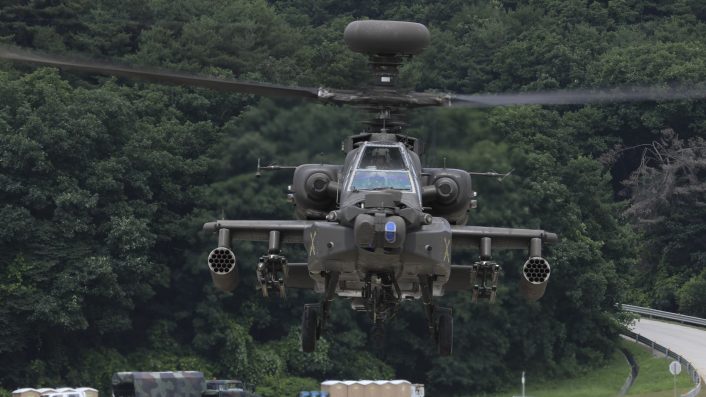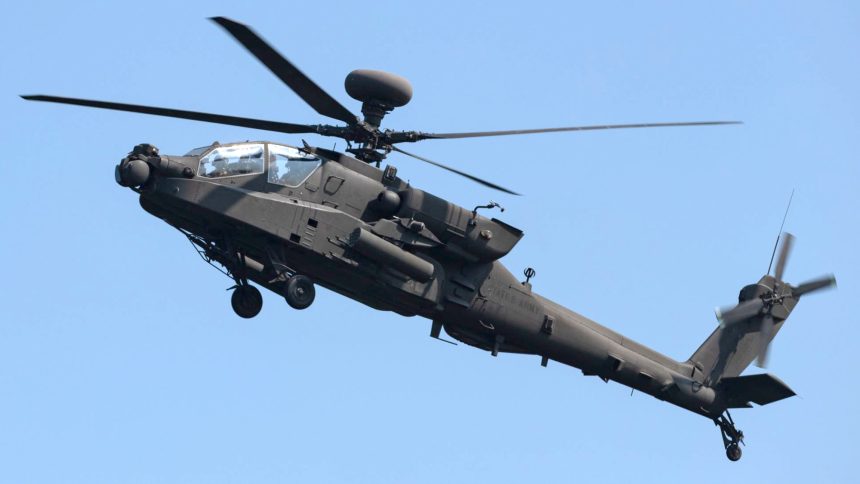South Korean officials questioned the wisdom of spending 70% of the Army’s annual budget on the Apaches considering how Russian attack helicopters were rapidly shot down by MANPADS during the Ukrainian war. Attack drones meanwhile have emerged as a cheaper and effective substitute.
South Korea is “reexamining” a plan to purchase additional 36 U.S.-made AH-64E Apache attack helicopters worth $3.5 billion, owing to lessons from Ukraine on the vulnerability of attack helicopters, the alternative provided by “attack” drones, and the high cost implications. Seoul’s defense planners believe UAVs have “changed modern warfare.”
A report on Chosun quoted military sources who observed how the “uselessness of (attack) helicopters” was seen in Ukraine when they were shot down by shoulder-fired MANPADs (Man-Portable Air Defenses). The RoKA (Republic of Korea Army) already operates 36 AH-64E Apaches, which were ordered in 2013 and delivered between 2016 and 2017.
Late in August 2024, the US State Department approved the FMS (Foreign Military Sale) deal for the additional 36. This also included 456 AGM-114R2 Hellfire missiles and 152 AGM-179A JAGM (Joint Air-to-Ground Missiles). Other related systems included target acquisition sights, fire-control radars, self-defensive EW (Electronic Warfare) suites, MWS (Missile Warning Systems), laser detectors, IFF (Identification Friend or Foe) transponders, among other detection and communication suites.
ROKA Aviation currently has 36 AH-64E Apaches in two attack heli battalions & was considering adopting another 36. The order may be reduced/canceled, as ROKA is considering investing in UAS, drone & loitering munitions that can provide similar capabilities.
(Pics from 76th AFday) https://t.co/UNWSSOw0O2 pic.twitter.com/UUBkHzGrHT
— Korea Defense Blog (@Korea_Defense) October 20, 2024
Lessons from Ukraine
The report said that the MND (Ministry of National Defense), the Army and the DAPA (Defense Acquisition Program Administration) have undertaken a “comprehensive review” of the introduction of 36 Apache attack helicopters. Drones meanwhile are being viewed as a cheaper yet effective substitute, driving the review on the “usability of attack helicopters.”
The unidentified military official added: “At the very least, the Army is unlikely to introduce all 36 units it has requested. Depending on the progress of the discussions, there is a possibility that the decision to introduce 36 units will be completely canceled.”
The report called the Apache the “world’s most powerful attack helicopter”, noting how it is nicknamed the “tank grim reaper.” However, seeing how Russian attack helicopters were rapidly shot down by “portable missiles,” raised a “question” among South Korean military planners.
Reportedly photos of Russian Ka-52 helicopter. Allegedly shot down by Wagner near the village of Talovaya, Voronezh region. pic.twitter.com/8mEoJxm9Ug
— Special Kherson Cat 🐈🇺🇦 (@bayraktar_1love) June 24, 2023
It is a different matter that both Russia, U.S.-led NATO, Turkey and China still see massive utility for attack helicopters. While a significant number of Russia’s Kamov Ka-52 Alligators were shot down, they were instrumental in destroying Ukraine’s Western-origin tank and armor with standoff long-range ATGM (Anti-Tank Guided Missiles) that contributed to Kyiv’s failed counteroffensive in the summer of 2023.
The U.S. Army is reorienting the Apache to its Cold War-era role of working together with forward scout helicopters and destroying Soviet tank columns, while also undertaking a major upgrade of its EW suites. Ukraine itself is seeking the AH-1Z Viper attack helicopter to maximize its benefits from the Kursk offensive. China meanwhile appears to be considering its Z-10 attack helicopter for even maritime warfare, beside employing them in a Taiwan invasion, beside traditional land wars. Thus, what might be driving South Korea’s aversion towards the Apache, could be something else entirely (to be touched upon subsequently).
Financial and diplomatic reasons
Officials also questioned the wisdom of spending “70% of the Army’s annual budget (approximately 6.5 trillion won or $4.68 billion) on the Apaches. In particular, the unit price for the first Apache introduction was 44.1 billion won ($31 million), but the expected price for the second introduction has “skyrocketed” to 73.3 billion won ($52 million), with a “possibility” of a “future increase.”

Interestingly, the report noted how the plan to purchase additional 36 Apaches was introduced during and “effectively scrapped” by the same previous government of President Moon Jae-in. A brainchild of former Minister of National Defense Song Young-moo’s “New Offensive Operation Plan”, the goal was “to end the war in two weeks” by “deploying special forces to Pyongyang using helicopters.”
However, the reconciliation and inter-Korean dialogue pushed by Moon Jae-in himself led to its unofficial demise. Chosun quoted People Power Party lawmaker Yoo Yong-won: “In a situation where cutting-edge power using unmanned attack aircraft is needed, it is time for our military to reexamine the introduction of additional attack helicopters with a huge budget according to the previous administration’s New Operation Plan.”
Pushing domestic LAH program?
It is possible that one of the reasons motivating the rethink on the AH-64E Apache could be the indigenous LAH (Light Armed Helicopter) project. In December 2023, KED Global reported that the DAPA announced plans to begin the “mass production” of homegrown air-to-ground guided missiles for the LAHs by 2031 in a $521 million project.
It said the KAI’s (Korea Aerospace Industries) LAH is expected to begin reaching Korean Armed Forces units by 2024 “to carry out air strikes and air assault missions.” KAI has also developed the KF-21 Boramae and the FA-50 light fighter. The LAH is expected to “become the core force of the ground troops.”
The report added that on Dec. 27, 2023, KAI signed a $1 billion contract with DAPA to supply LAHs beginning 2025. This marked the second supply agreement for the helicopter between KAI and DAPA.
South Korea Offer Malaysia to buy KAI LAH Light Attack Helicopter, I like it the design anyway .
Might even better than MD-530G or AH-64E.. ?
What do you think ? pic.twitter.com/scqyyUkq7i
— The Tsoi Gun 🇲🇾 (@CallSignTsoi) October 20, 2024
The real lesson from Ukraine
A war with North Korea will require at least a significant number of indigenously developed platforms to aid scaling up production, replenish losses and quickly incorporate upgrades or tweaks from experience gained both during training and combat.
Ukraine does not have these options since it now completely relies on Western equipment, none of which is manufactured within the country, but is rather supplied from the NATO member nations’ own inventories. Seoul has seen how Russia exploited the delay in arrival of major Western weapons like the M1A1 Abrams tanks and the F-16 fighters to capture more ground and offset any future gains the platforms may accrue.
The IAF’s AH-64E Apaches come with AIM-92 Stinger air-to-air missiles, demonstrated live here by a Korean Army AH-64E in an exercise last December. (Video/ROK Army) pic.twitter.com/QNsdSqCuKA
— Livefist (@livefist) July 28, 2018
Lastly, U.S’s Asian Allies have been increasingly turning inwards for their defense equipment needs. The Aviationist recently reported how Japan MoD is pushing its own dedicated EW (Electronic Warfare) aircraft based on the fully indigenous Kawasaki P-1 MPA (Maritime Patrol Aircraft). Reports and MoD budget documents said that foreign platforms do not meet its needs, while “sensitive” technologies like EW are difficult to acquire from “overseas.”









